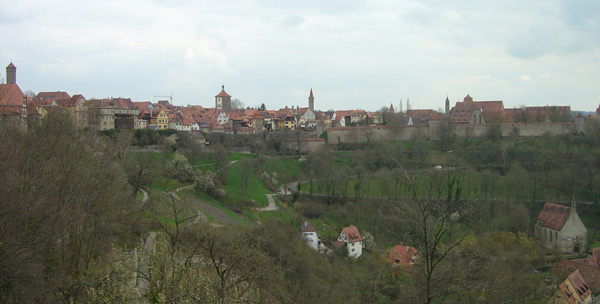
 |
We'll start off with a little history -- right from the
Rothenburg website:
Rothenburg ob der Tauber, (pronounced Roe-ten-burg),
is probably the best preserved medieval town. About 500 years BC,
Celtic tribes built a fortification on the western slopes of the Tauber
valley (Engelsburg). The village of Detwang, nowadays part of the town,
was founded about 960 a.d.. Ten years later, the first medieval
stronghold was built.
In 1142 it was joined by an imperial castle, ordered by Emperor Konrad III, but an earthquake destroyed both castles in 1356. The town was rebuilt and developed into a trading center. Soon the town occupied a leading place among the powerful communities of Southern Germany. Its territory consisted of about 180 settlements. In 1400 Rothenburg`s population was 6,000.
In 1631, during the Thirty Years War, total destruction
of the town was apparently averted by the famous ´Master Draught`,
when ex-mayor, Georg Nusch, consumed 3.25 liters of wine in a single draught.
From 1650 on, until the beginning of the last century, Rothenburg belonged
to the myriad of tiny, insignificant towns which existed in Central Europe
at that time.
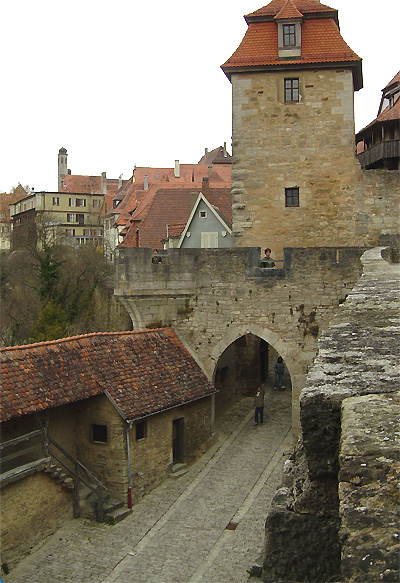
Here's an entry into town. Mitch and Max are looking out the openings above the arch. |
The year of 1802 brought the end of independence. Rothenburg was incorporated into the kingdom of Bavaria. Later, during the following Romantic period of German art, the well preserved medieval town became a Mecca for painters and poets. Unfortunately, World War II didn't pass without leaving
its marks. March 31, 1945, the day before Easter, an allied bombardment
destroyed the east of the old town. But fortunately the historical center
remained untouched. In spite of the poorness of the years after the war,
the inhabitants of Rothenburg were able to rebuild the destroyed parts
according to the medieval plans. For more information on Rothenburg
visit http://www.rothenburg-online.de
Rothenburg was our last stop on this European trip. You might have thought we'd had enough castles and history by now, but then we found Rothenburg. This little town in completely enclosed in a wall.
Though a portion of the wall was bombed during World War II and replaced
with a smaller version of the original, it's easy to imagine what the city
originally looked like -- that's because it's been completely preserved.
|
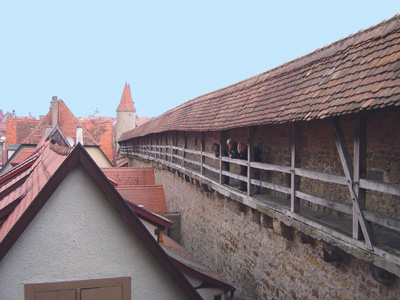 |
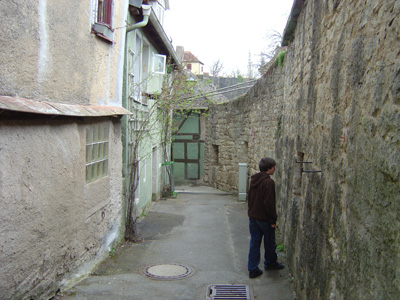 |
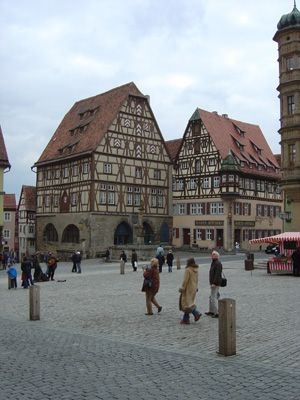
Market Square |
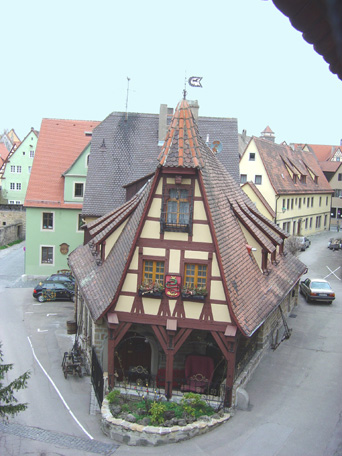
I can see where Walt Disney got some of his ideas for Disneyland. |
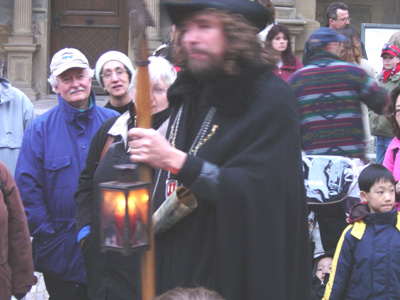
Hans Georg Baumgartner, the Night Watchman |
|
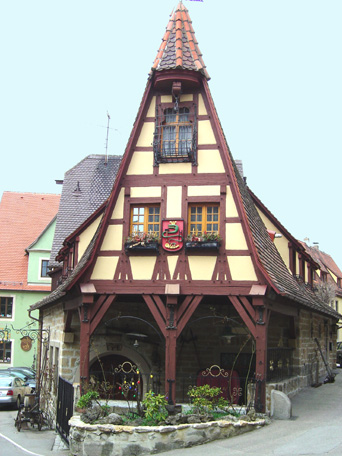 |
This is such a cool building that we had to put it in twice. |
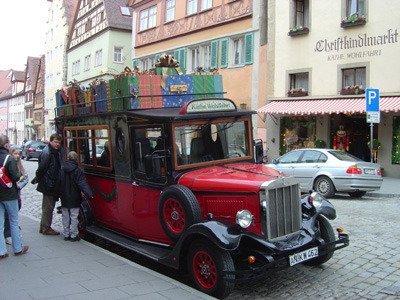
|
Rothenburg survives on tourism. We usually come to a
place like this to see its sights and learn its history. Shopping
isn't a priority.
We did go into the well known Christmas store for a look, and departed quickly as it was literally packed with middle-aged and older American women with East Coast accents. |
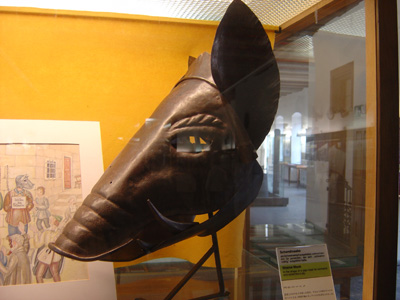 |
There is a unique museum in Rothenburg called the Medieval
Crime and Punishment Museum. I was a little leery about going to
it after the blood-and-guts tour we had at the Tower of London a couple
of years ago. However, though it was a little gory, it was very informative
and interesting.
We learned that one form of medieval punishment was public shame. The convicted person was chained in the city square and forced to wear this or a similar mask as a form of public humiliation. The punishment for arguing too loudly with your wife was to be locked in your house until you made up. If two woman were arguing in public they were locked in a shackle around their necks holding them face to face about one foot apart until they made up. Bakers were required to make bread that met strict weight requirements. Try to cheat the customers and they were locked in a large basket and dipped repeatedly into the town well or the river. But try to make the bread too heavy and out-do the competition and you would get the same treatment. We spent several hours reading through all of the various crimes, punishments and tools of the trade. Many I didn't describe were outright torture. It was also considered common practice to use various forms of torture to acquire confessions to determine innocence or guilt. I started to realize why Germans seem to demand perfection
and obedience.
|
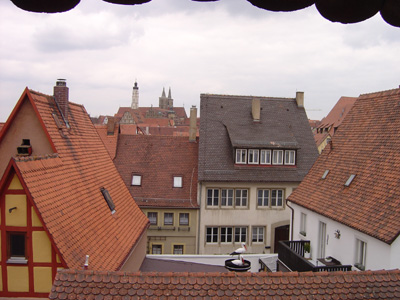 |
Most of the roofs in Rothenburg are of red tile. What caught my eye here, are the birds resting on the chimney in the foreground. I wonder if they are storks. |
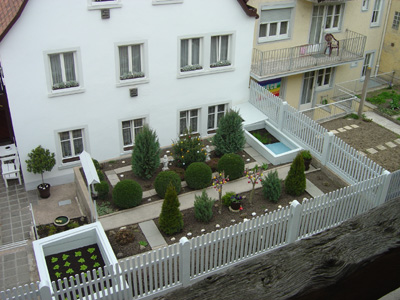 |
Even the gravel was carefully raked into a beautiful pattern. Now I wonder, is it because thousands of tourists walk past here looking down into the yard, or is it a family trait -- a genetic condition, found in their DNA after centuries of perfection or the threat of torture? |
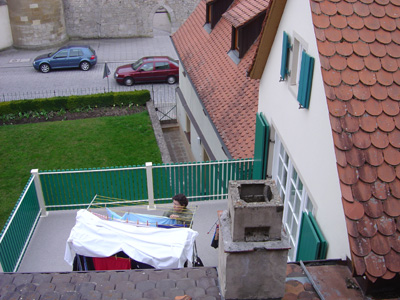 |
I guess you'd get used to having people walking along your roof line after a while. This house butts right up to the wall. |
| Most people would want a great German dinner while visiting
Rothenburg ob der Tauber. But it's been almost two weeks since we
left Venice and word had it that there was a great authentic Italian restaurant
in town.
True to its reputation, this was an excellent anchovy and olive pizza. Now, if only I could order it on-line for a reasonable price. |
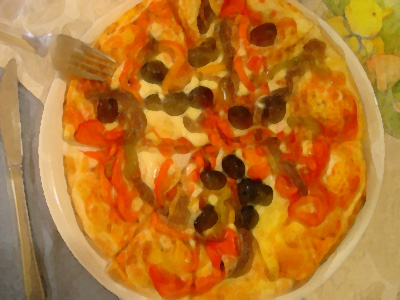 |
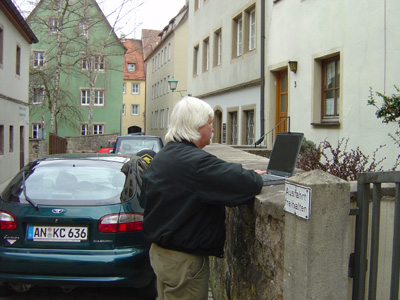 |
I walked back and forth trying to find the source of the signal. I was about to give up, when I thought maybe I should move around more due to all the two foot rock walls. Sure enough, I started walking, the signal disappeared, and then jumped up to 95%. The building down the street, past the two cars, was an architectural firm with an open high-speed wireless signal. I was able to transfer several megabytes of data. (Yes, we must work to pay for these trips.) |
|
|
|
|
Next Adventure (Building Sandrails) |